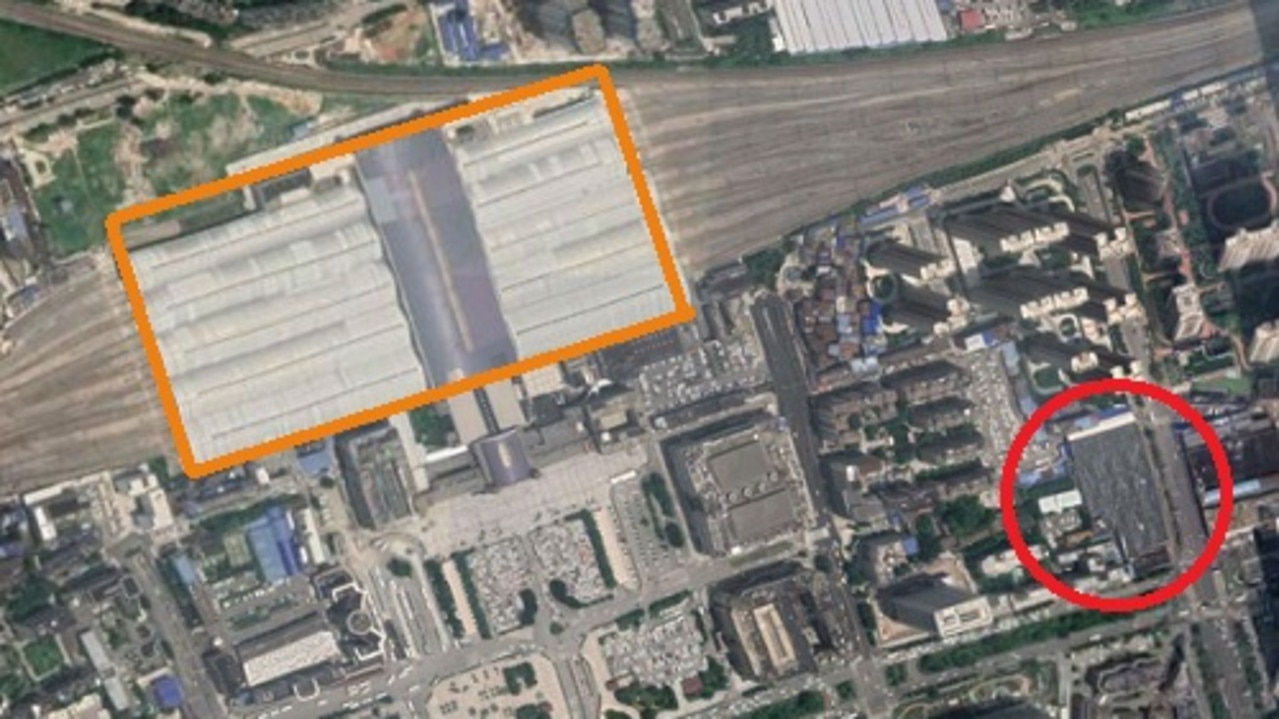Map shows how Coronavirus spread from Huanan fish market around the world
A satellite map of Wuhan in China shows where the coronavirus started and how it became a global health problem.
A satellite map of Wuhan shows how the coronavirus was easily able to spread from a live animal market to the rest of China.
Since it was first detected towards the end of 2019, the coronavirus has infected more than 2000 people and killed at least 80.
Huanan market, where officials say the virus first jumped from animal to person, sits in the heart of Wuhan city.
Hankou train station, a large station that connects the city to the rest of China, is only a kilometre away.

Just yesterday, China’s health minister confirmed it is possible for people to spread the virus before they have symptoms — meaning people who became infected at the market could have easily spread it through the busy transport hub and around the country without even realising they were infected.
Wuhan is just one city among several densely-populated areas along the Yangtze River. Most identified cases of coronavirus are in this area.
More than nine million people live in the city of Wuhan — more than a third of Australia’s entire population. The city remains in lockdown, and Beijing has issued a recent order banning all international group travel.
So far there have been five confirmed cases of coronavirus in Australia — the fifth confirmed today as a 21-year-old Chinese woman in NSW. In China, the virus death toll has leapt to 80, with more than 2300 cases confirmed, the government says.
RELATED: Virus death toll suddenly spikes
RELATED: Signs of killer virus to watch for
RELATED: How to avoid contracting coronavirus
RELATED: Another case of coronavirus expected
All the ways the virus can be transmitted are unclear, but China’s National Health Commission Minister Ma Xiaowei revealed the incubation period for the virus could range from one to 14 days, and the virus was infectious during incubation, meaning it can be spread before someone has symptoms.
“According to recent clinical information, the virus’s ability to spread seems to be getting somewhat stronger,” Mr Ma told a packed media briefing on the second day of the Lunar New Year holiday.
Containment efforts, which have thus far included transportation and travel curbs and the cancellation of big events, would be intensified, Mr Ma said.
The coronavirus being able to be spread during the incubation period makes it different to severe acute respiratory syndrome (SARS).
SARS was a coronavirus that originated in China and killed nearly 800 people globally in 2002 and 2003.
The lead doctor treating two Paris hospital patients infected with conoravirus believes the virus looks less deadly than SARS.
“This illness is a lot less serious – and we don’t say this based on two patients but talking to our international colleagues – than, for example, SARS,” Dr Yazdan Yazdanpaneh told AP.
The mortality rate for the viral illness identified in China last month is thought to be less than 5 per cent, whereas it was double that for SARS, he said.
It is not clear how lethal the new coronavirus is or even whether it is as dangerous as the ordinary flu, which kills tens of thousands of people every year in the US alone.
Those killed by the virus have mostly been middle-aged or elderly people, sometimes suffering from other conditions that weaken their ability to fight back.
Investigators were closely observing whether the virus was mutating but thus far found “no obvious signs” that it was doing so, head of the Chinese Centre for Disease Control, Gao Fu, told reporters.

That could make it easier to develop vaccines against the virus, something the centre is already working on.
Xinhua quoted centre official Xu Wenbo as saying the they had isolated the virus and were identifying seed strain.
The rapid increase in reported deaths and illnesses does not necessarily mean the crisis is getting worse but could reflect better monitoring and reporting of the virus.
The new virus comes from a large family of what are known as coronaviruses, some causing nothing worse than a cold. It causes cold-and flu-like symptoms, including cough and fever, and in more severe cases, shortness of breath. It can worsen to pneumonia, which can be fatal.
Each person infected with coronavirus is passing the disease on to between two and three other people on average at current transmission rates, according to two separate scientific analyses of the epidemic.
Whether the outbreak will continue to spread at this rate depends on the effectiveness of control measures, the scientists who conducted the studies said.
But to be able to contain the epidemic and turn the tide of infections, control measures would have to halt transmission in at least 60 per cent of cases.

More than 2000 people are infected worldwide — the vast majority in China.
“It is unclear at the current time whether this outbreak can be contained within China,” said Neil Ferguson, an infectious disease specialist at Imperial College London who co-led one of the studies.
Prof Ferguson’s team suggest as many as 4000 people in Wuhan were already infected by January 18 and that on average each case was infecting two or three others.
A second study by researchers at Britain’s Lancaster University also calculated the contagion rate at 2.5 new people on average being infected by each person already infected.
“Should the epidemic continue unabated in Wuhan, we predict (it) will be substantially larger by February 4,” the scientists wrote.
They estimated that the central Chinese city of Wuhan, where the outbreak began in December, would alone have around 190,000 cases of infection by Feburay 4, and that “infection will be established in other Chinese cities, and importations to other countries will be more frequent”.

Raina MacIntyre, head of the Biosecurity Research Program at the Kirby Institute at the University of New South Wales, said on Saturday it was highly concerning that in recent days the infection had become widespread.
“The more widespread the infection in other parts of the China, the greater the risk of more global spread,” Prof MacIntyre said.
Australia, a popular destination for Chinese visitors, confirmed its first four cases of the virus in travellers from China, all of whom had been to Wuhan.
“What we need is more data to be published on risk factors, transmission, incubation period and epidemiology so we can understand what control measures are most appropriate,” Prof MacIntyre said.
— with wires



